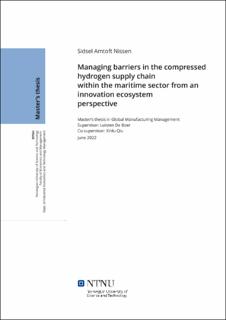| dc.description.abstract | This master thesis aims to investigate how actors within the compressed hydrogen supply chain can overcome the present barriers while staying aligned. The focus of the thesis is a potential future project where the actors seek to invest in compressed hydrogen as an alternative to maritime fossil fuels. The power company, TronderEnergi, is interested in becoming a hydrogen manufacturer in Trondelag and supplying hydrogen for maritime use. The shipping company, AQS, searches for alternatives to fossil fuels. AQS can, thus, become a potential customer of TronderEnergi. For TronderEnergi and AQS to raise the odds for project success the barriers along the entire supply
chain must be managed. The thesis will assess how TronderEnergi and its co-actors perceive the same barriers, how they think the barriers can be solved, and whether they are aligned in their way of managing them. Three literature research have been conducted within the field of barriers in the hydrogen supply chain, designing a supply chain, and innovation ecosystem. The theory will act as the foundation to a developed conceptual framework whose purpose is to contribute to assessing the barriers, the ecosystem risk, and aligning the supply chain actors.
A qualitative case study was conducted with TronderEnergi, AQS, and Ocean Hyway Cluster to understand how they perceive the same barriers, and how they see them being managed. The conducted interviews were used in the conceptual framework to gain a complete overview of the innovation project, and its risk concerning co-innovation and adoption chain actors, and to examine if the actors are aligned. It was discovered that there is consensus between what the three actors understand as barriers, and further, that they are aligned in how to manage them. A discussion took place on the outcome of the applied conceptual framework and the concerned theories. The conclusion was that the conceptual framework showed potential to be applied in understanding issues and solutions from other perspectives than the focal firms. However, it was not found to be adequate to the extent it is desired for TronderEnergi. This will require an extension of the conceptual framework with support from other theories and frameworks. | |
